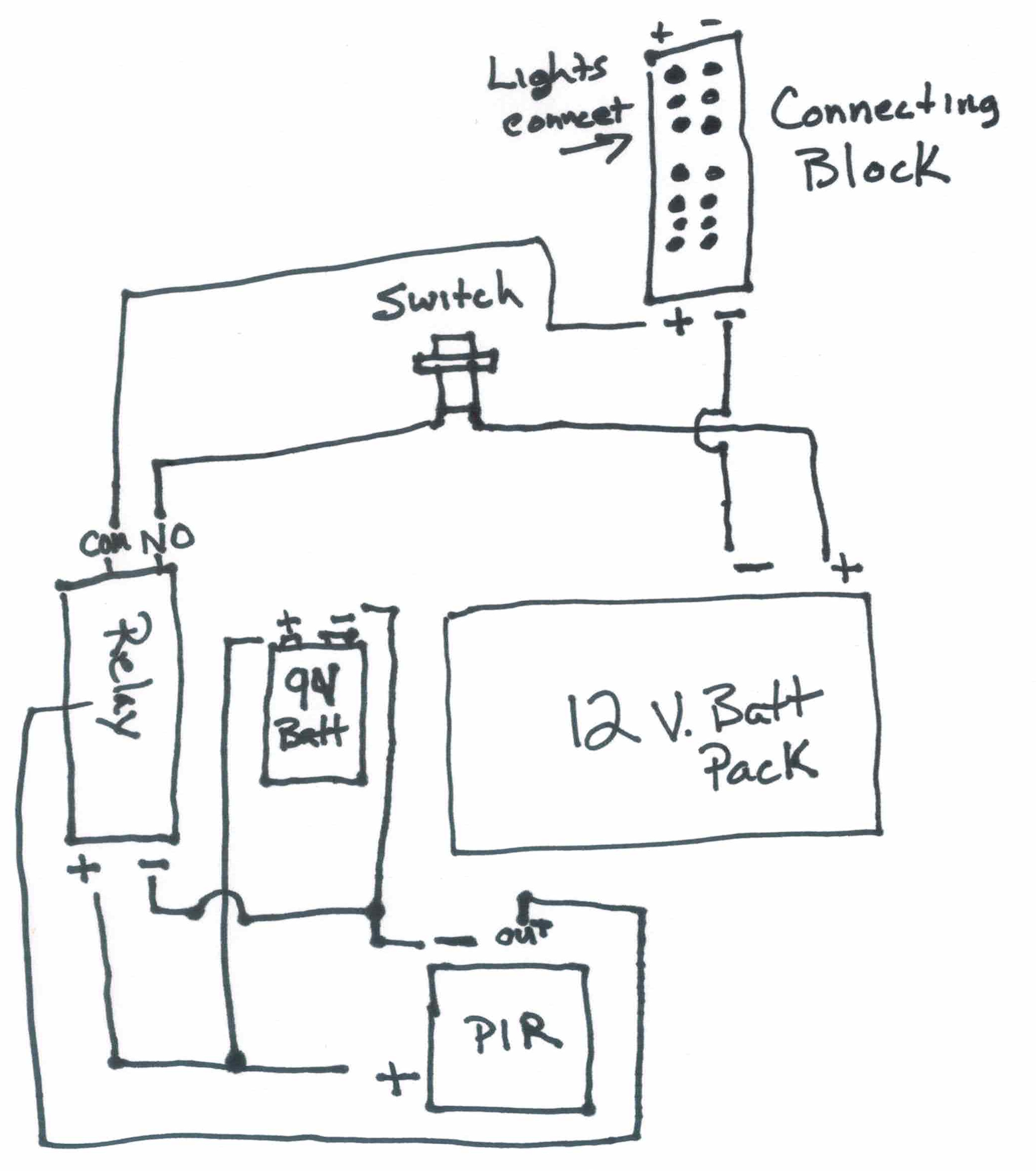This tutorial will show how to make a Trick-or-Treat Alarm. Detect those kids before they get to your front door!. Set it outside to spook the Trick-or Treaters as they walk up to your door. Or, spook away the those neighborhood pumpkin smashers as creep up to your pumpkins.
The alarm is motion activated. Upon activate an ear piercing tone will get the attention of the ghosts and goblins approaching your house. The skulls will light up with red piercing eyes and the brains inside the skull will be swirling inside.
In a nutshell, this tutorial will show how to create a circuit including a PIR motion detector sensor, 3v relay, and individual LED lights.
A great and UNIQUE Halloween Haunted House decoration or bookshelf light with LED lighting.
NOTE: Due to a bad PIR Sensor purchased through Amazon... I had to resort back to one of my first tutorials on showing how to make a PIR/Relay circuit. Be sure to check it out.
3v PIR Motion Sensor Driving a (Defective) 3v Relay Module
Step 1: Spooky and Scary Motion ActivatedEnjoy the show! Buzzer is not connected for demo!
Direct Link to YouTube Video Here! https://youtu.be/NhANaEUEGhs
Step 2: The Box Base and Mounting HolesThe purpose of the box is to hide all the electronics and wiring as well as provide a good base for the skulls. I purchased the box at a local craft store for $2. Always try to take advantage of sales at the craft stores as they tend to be a little pricey with their regular retail pricing.
Tools and Materials
- Wood Craft Box 8 1/2" x 5 5/16" x 3 9/16"
- Drill press or Drill
- 1/2 inch Spade Bit
- 5/8 inch Spade Bit
Drill the holes for mounting of motion sensor and power button.
- Drill 5/8 inch hole in from for PIR light sensor
- Drill 1/2 inch hole for power button.
- Tapper from inside of box the power button hole with a dremel to allow for switch nut.
- Dry fit the PIR Sensor
Perfect Fit!
Step 3: Paint and Finish BoxesUse your favorite color of spray primer/paint and a couple coats of clear finish on the inside and outside of box.
Step 4: LED Lights and BuzzerI will be using two different size and types of LED lights for this project. Both I have used for previous projects and have been very happy with their performance. All lights are pre wired with resistors which cost a little more but save lots of time by not having to wire in your own resistors.
DC 3-24V 85dB Sound Electronic Buzzer Alarm (noise maker to scare away intruders) Not Pictured
- 3mm led Pre Wired light RGB Fast Flash Flashing 12V (4 bullbs for inside the skulls)
- 5mm Leds Pre Wired Light 12v 20cm Bulb (4 red bulbs for eyes)
- 5mm Leds Pre Wired Light 12v 20cm Bulb (2 yellow bulbs for base/mouth of skull)
Before I start working with the lights I test each one with a 3v button battery. I am always testing the lights throughout the build in case I accidentally break a wire.
Step 5: Solder Lead Wires and Heat Shrink InsulationYou get about 6-8 inches of wire to work with on these LED lights. I liked to add lead wires to make working with them a little easier.
Tools and Materials
- Wire cutters and strippers
- Solder iron
- Solder
- Helping Hands to hold wire while soldering
- Heat Shrink
- Heat source to shrink insulation (use a heat gun or lighter)
To Do
- Strip lead wire and light wires about 1 inch.
- Twist together
- Solder the connections
- Apply heat shrink insulation to cover and protect connection
Drill holes for light placement and feeding wires into the skulls from the base box. The LED lights come wired with a resistor inline. In order to mount the lights into the hole neatly and secure I used 5mm LED holders.
Tools
- Power Drill
- 5/16 inch drill bit
- 1/2 inch drill bit
To Do:
- Use 5/16 drill bit to drill holes for eye holes and base of skull light
- use 1/2 drill bit to drill hole for wire access to skull.
- Feed ends of wires into each light hole to the bottom of skull
- Pull wires out of bottom of skull
- Repeat for second skull.
Throughout the entire process test your lights to check for any broken connections during the build.
- Tie all your red + wires together
- Tie all your black - wires together.
- Connect red wires to + power source
- Connect black wires to - power source
FYI... I have a multi voltage power supply I built that I can apply power easily. I tested with 3.2v, 5v, and 12v. All lights power for each level of power. Obviously 12v is produces a brighter light than the lower voltages. These LEDs are rated up to 12v. My plan will include powering the lights with an 8AA battery pack to give me 12 volts for the light and buzzer.
All connections appear to be good and working. Repeat for second skull.
Step 9: Secure Lights and WiringTools and Materials
- Hot Glue Gun
- Hot Glue Sticks
- Small Tie Wraps
When dry fitting the LED holders I discovered a 1/4 inch hole was too small and a 5/16 inch hole was a little too big to get a snug fit into the holes. So, I brought out the hot glue gun to secure the LEDs into the holes. Just a little bit of glue was needed. I then secured all wires together at the base of skull and tucked the tie wrap into the skull.
NOTE: The 3mm flashing lights are secured with the wiring of the other lights to let them float inside the skull space.
Skulls are now ready for testing with the PIR motion sensor.
Step 10: PIR Motion SensorAs shown in Step 1, the PIR Motion Sensor will be disassembled for installation. The case comes apart easily with a small screw driver.
Sensor comes with connectors as pictured.
NOTE: Upon opening the case I noticed there is only one adjuster for this PIR. If you check the Amazon web site for this sensor there are supposed to be 2 adjusters. There should be an adjuster for delay (ON) time and sensor sensitivity. At the time of this tutorial, I am contacting Amazon to get a replacement or refund. When I get the correct sensor I will swap them out.
Step 11: Test PIR Motion SensorNow that I know the wiring is all good with the lights, time to test the PIR Motion Sensor.
- Connect all black - wires together
- Connect all red + wires together
- Connect PIR OUT + and - to LED wires
- Connect + and - from power supply to PIR IN
- Power On Power Supply
Lights are ON!
OK... so everything is powered on! Great... Right?!?
Not so fast... this is why we test! This sensor was advertised to trigger off after 5-10 seconds. Well, the lights were not powering off. And, I did cover the sensor so that it did not detect my motion. After several tests and making minor changes with the adjust inside the PIR case I got it to work. So... we have a faulty sensor that works sometimes. DARN! It will have to do until a replacement arrives.
Step 12: Bad PIR Motion SensorAfter comparing the pictures from the Amazon web site I received Verson 1 of the sensor when I was supposed to receive Version 1.2 with two adjusters. Version 1 must just be a bad product. See image and details below.
- Sensor I received. Missing an adjuster. Unsure of purpose of the adjuster in (1). It is either sensitivity or time.
- Sensor I was supposed to receive. Waiting to hear back from seller as to whether I will receive a refund or replacement.
Update: Not going to wait for seller from China to decide, the tutorial must go on!
For the following steps refer to another tutorial I did to get a faulty Relay and Circuit to work together.
3v PIR Motion Sensor Driving a (Defective) 3v Relay Module
Step 13: Install Wires and SkullsNow comes the fun part. It is time to install all components and connect the circuit.
- Drill 2 1/2 inch holes in top of box placed to your liking.
- Feed wires from outside top of box to inside of box.
- Glue Skulls to outside top of box with hot glue.
- Attach connecting block to inside top of box with Velcro.
- Glue buzzer to inside top of box with hot glue
- As you remove labels from wires connect to connecting block.
The new PIR sensor lens is too large to fit the hole of the box. Therefore, I have taken the lens off the faulty PIR and installed onto the new PIR. It was simply pull off and swap of lens that fits nicely over the sensor.
Install PIR sensor into hole and apply a little hot glue to keep it in place.
Step 15: Install Power Switch, Relay, and BatteriesComponents used in this circuit are as follows.
- 8x AA Battery Pack 12v power source for LED lights
- 9v Battery use as power source for PIR sensor and Relay.
- Latching Button Switch
- PIR Sensor
- 3v Relay Module (may also use 5v Relay)
See my wiring diagram. Hope this is acceptable. I am by no means and electrician, but this should be easy enough to follow. I added the other images to cross reference as I believe your components might be different that you purchase.
Step 17: Power It Up!Since you have been testing as you go, all you should need to do is...
- Connect 9v to 9v connector
- Turn on 12v battery pack.
- Close Box.
- Turn on main power switch in back of box.
Enjoy the show, and enjoy watching the kids jump as they approach your house.
WARNING! If you use the same buzzer as me, be warned that it is a very high pitch and might hurt YOUR ears. If you want to just use this as an indoor decoration with the motion activation and lights, disconnect the buzzer wires at the connecting block.
After running for the first time I realized the power switch in the back will only power on and off the lights. The circuit is still live between the PIR and Relay. So, either disconnect the 9v battery to save the power when not in use or install another switch to kill the PIR/Relay circuit.
If anybody has another option for an audible 12v signal instead of the buzzer, please share. A scary voice or music would be a cool alternative.
Still looking for a quality 12v PIR sensor. The KANG product just does not seem to work. Perhaps they are just junk coming from China through Amazon. Would love to get this to my original plan of just a powered PIR without the additional 9v battery and relay circuit.
Cost... Just in case you are interested.
2.00 Box
2.00 Skulls
2.50 PIR
2,25 Relay
0.50 Switch
0.96 Large LEDs
0.88 Small Flashing LEDs
2.50 12v Battery Holder
3.00 Misc. Materials (Wire, solder, paint, etc.)
16.59 Total
Happy Halloween Everybody














Comments
Please log in or sign up to comment.